May 24th, 2011
Pretty in Pink…and Coral
Is there any other flower that inspires more color lust than a rose? That is the question posed in this month’s House Beautiful’s Paint Palette page-one of my favorite parts of the magazine. Last month, we looked at Shades of Sea Glass.
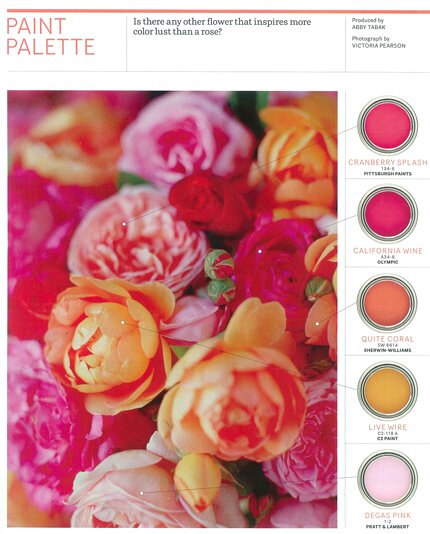
This month’s palette features my favorite floral color combination: hot pink, pale rose, and orange-y coral. I used this color combination as the theme for my wedding flowers last August. Below, they are realized in some inspirational room settings with Royal Design Studio stencils…..
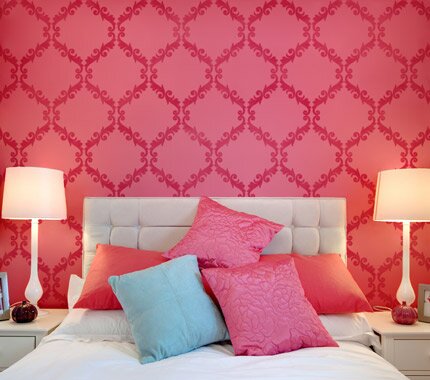
Small Acanthus Trellis wall stencil in hot pink and fuschia.
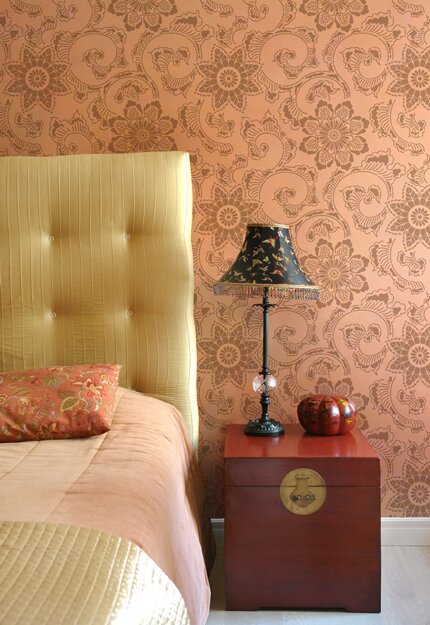
Kimono Allover Japanese wall stencil in a soft, soothing coral.
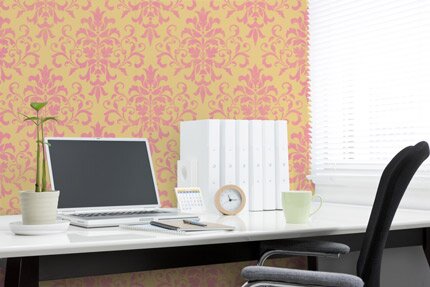
Foliate Damask allover wall stencil in petal pink on golden yellow.

Small Berry Romantic floral wall stencil in hot pink, cranberry, and coral.
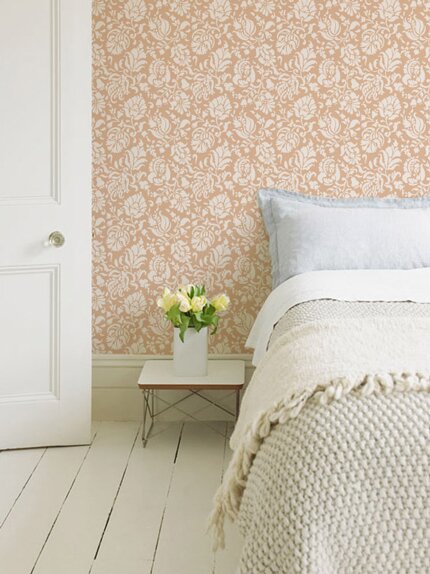
Large Allover Brocade damask wall stencil in cream over a dusty coral base.

Silk Road Suzani wall stencil in rose over the palest petal pink. Don’t forget to stop and smell the roses today!
May 19th, 2011
Ripped from the pages of…
Do you ever look through home decorating magazines tear out more inspiring images from ads than from actual homes?? There are actually some very nice home features in the June issue of Elle Decor, but the ads “had it” by a long shot for me this morning. For instance, I am loving…
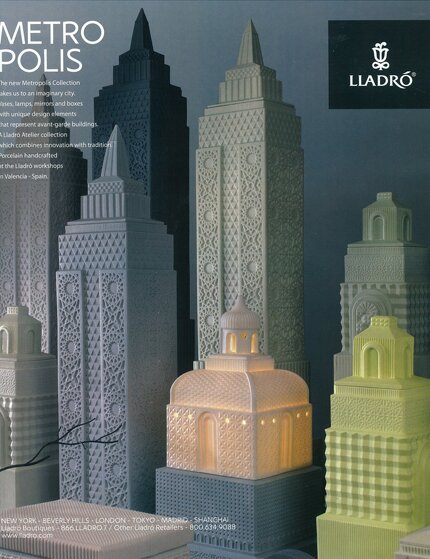
The new Metropolis collection from the amazing Lladro workshops in Valencia, Spain. These are like Empire State Building meets Moroccan bell tower. So cool!

All the chalky white finishes against the old brick wall. Love the dresser finish, the wall carving, the jar, the flowers….well all of it from Empty Vase Florist.
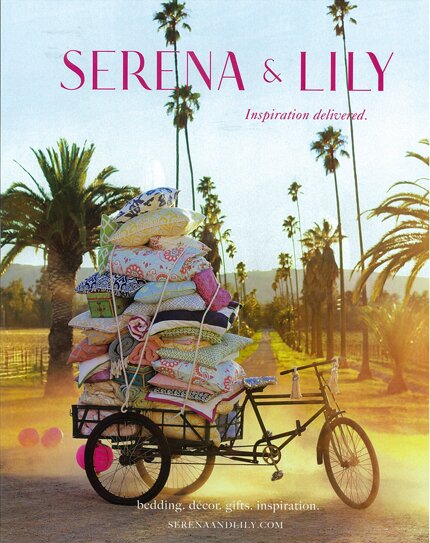
Serena and Lily has a lovely, clean, and colorful website. I love their way with fabrics and noticed that they also now have a coordinating paint collection to match.

OK, so Rocky Mountain does have beautiful hardware, but I really think the distressed wood finishes in this photo make them look AMAZING!

Diane von Furstenberg’s new “Bishop’s Cape” rug for The Rug Company does actually look like it was lifted from a Medieval church. I love the well-worn look.
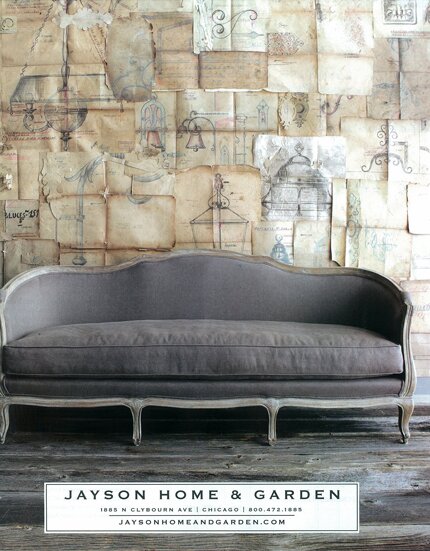
And last but not least, my most favoritest thing. This ad for Jayson Home and Garden features a wallpaperish collage of blown up architectural drawings. I think this looks amazing! As I have access to the Julia Morgan archives for The Hearst Castle Collection to design our new stencil line from, this is something that I actually could (and may) do!!
May 11th, 2011
Chalkin it up!
I think it’s a sign of the trend towards simplicity, rehabbing, and cost cutting that the hottest thing in decorative finishing right now is……PAINT!
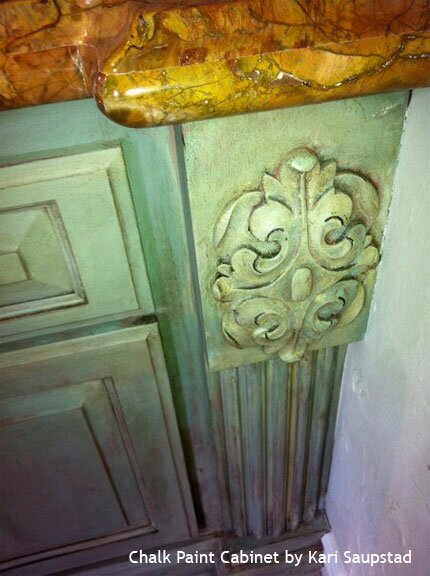
Well, not just any paint, but Annie Sloane’s ubiquitous Chalk Paint.
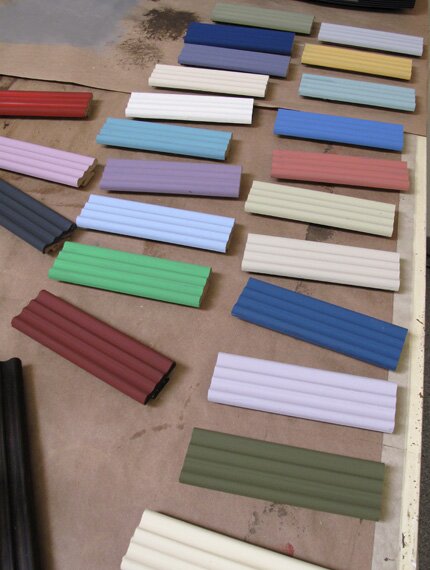
And it’s no wonder. This paint comes in 24 delicious colors to mix, layer, antique, distress, and wax to a lovely patina. It can be applied directly over most substrates without priming, making it a prime CAN-didate for freshening up (or distressing up) old funiture, accessories and cabinetry. From the website:
Painting with our paint should always be a pleasure.
Annie Sloan developed her now famous Chalk Paint to answer the need she had for a paint which would have many uses from acting like lime wash to looking like old painted furniture and that had a good range of colour that could be extended by the user. This paint is very easy to work with and allows people to be creative as one doesn’t get involved with the technicalities of preparation and it also allows you to change your mind without hassle.
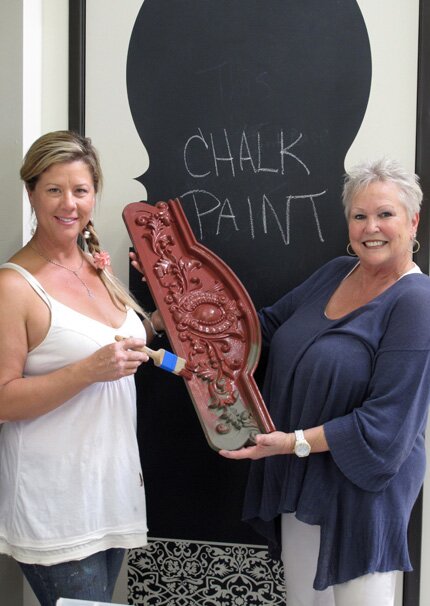
I will be hosting a one day Chalk Paint workshop here at my San Diego studio on Saturday, June 11, to be led by my talented friend Kari Saupstad along with Anne Skougard from House of Anne. One day last week, Kari and Anne came by for a little “Chalk Play Day”, to make some samples for the class and just generally have fun! Here’s a little look-see at what we came up with…..
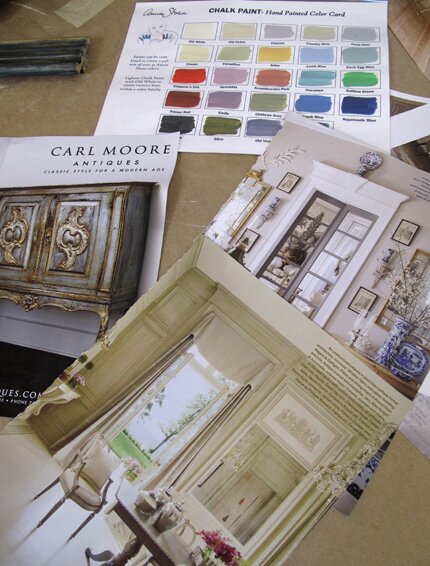
I had pulled some tear sheets from the latest issue of Veranda magazine, which is FILLED with page after page of gorgeous painted furniture finishes-all easily achievable with Chalk Paint!
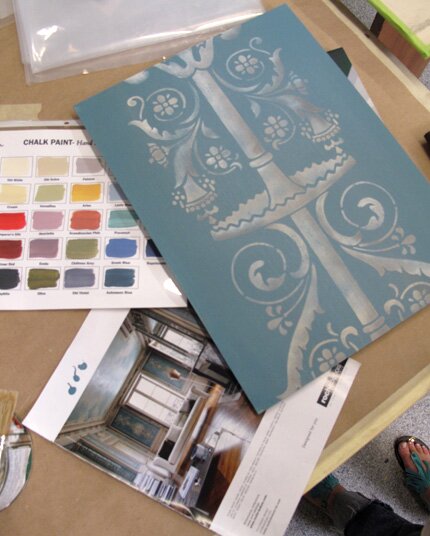
Of course, we had to do a little stenciling…
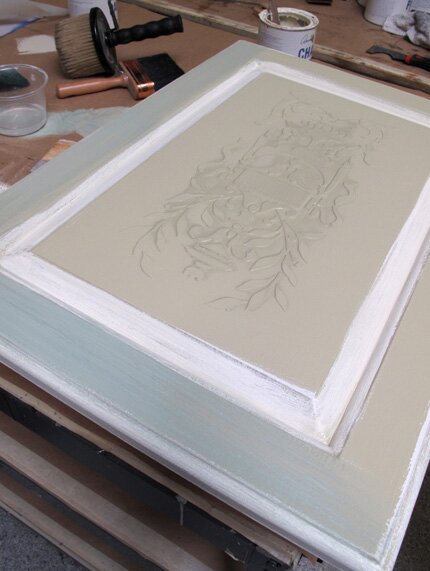
This was an MDF door sample I had had laying around for years just “being boring”, so I gave it a raised stencil image with our Parisian Urn Panel stencil, and Kari gave it a new and more interesting life with a few quick layers of paint.
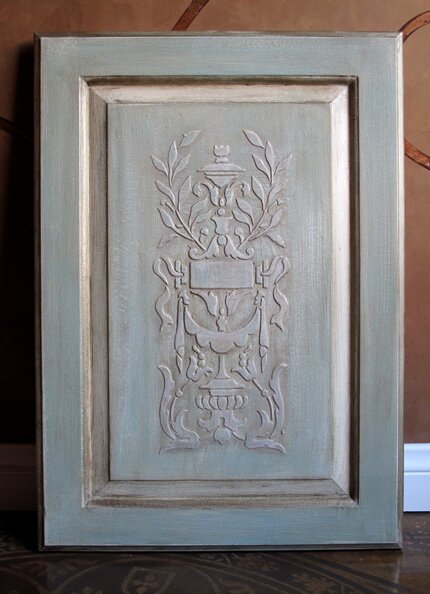
It’s much happier now. Can you tell?

I also played around with another embossed stencil pattern, our new Indian Paisley Damask.
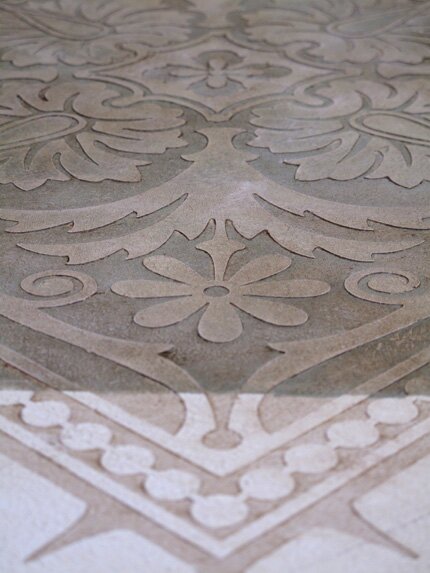
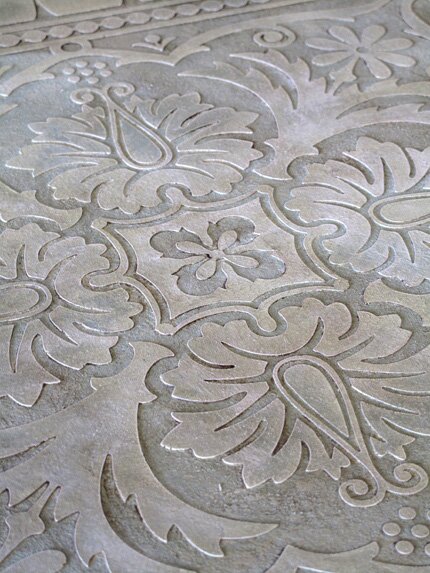
Another thought I had was that if Chalk Paint is good for bring new life to old furniture, it could also be good for bringing new life to old samples boards, and I certainly have plenty of THOSE laying around! This was an embossed plaster finish I had done years ago with one of our Modello tile patterns.

And here’s a closeup of the other stenciled paint finish using our Royal Design Studio Pompeii Pedestal stencil.

Kari, Anne, and I would love to have you join us to get your hands both IN this paint, and ON 8 fabulous samples. You will explore: two-color, rustic, crackles, limed wash, clouded stipple and mixed and waxed paint, along with a heavenly Chateau wash wall finish and a stenciled panel. You can download more info on this workshop by clicking here and register on the House of Anne website.
May 9th, 2011
Spanish Influences
There are two major projects that are the focus of most of my thoughts these days (though it’s pretty crowded inside my head, as usual!). They are: my upcoming painting trip to Spain, AND my new collection of stencils and Modello patterns for The Hearst Castle Collection, inspired by Julia Morgan’s architectural drawings.
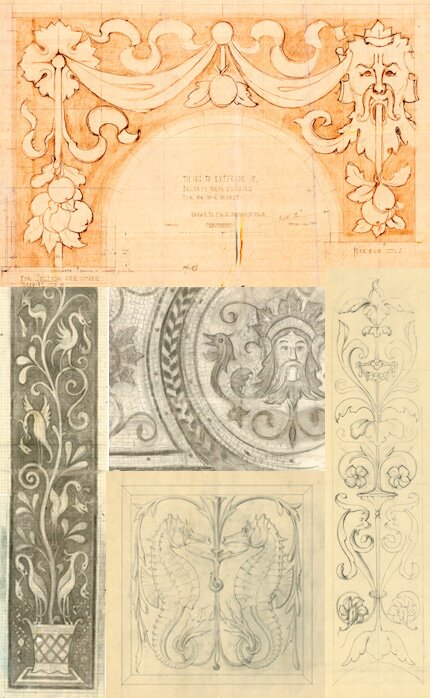
With this post I get to combine the both. You see, much of the influence and architectural features for the design and furnishing of Hearst Castle came from Spain. They were able to rescue and repurpose whole antique ceilings from churches, monasteries, palaces, and villas. Nonetheless, a great deal of the relief plaster, tiles, ironwork, moldings, coffered ceilings, wall treatments, etc. were designed by Morgan herself and fabricated by local California artisans. Now, I have the happy job of translating Morgan’s extensive design talents into classically inspired stencils that decorative artisans can use for years to come.
And what better time to introduce these new designs than for the hands-on class I will be teaching my students at the monastery outside of Barcelona? After much thought and image sifting, I had landed on these lovely samples to start with. The students will have the opportunity to be the first to work with these new designs in a combination of stenciling and hand painting techniques. We will be working on and with a variety of materials, including silk linen, SkimStone, plaster, and gilding, to create faux mosaic, Spanish-style glazed and crackled tiles, grisaille painting, and more.
So, if you are saying to yourself, “self, I REALLY wish I was going on this amazing, artistic adventure with Melanie and a lovely group of ladies” then I have great news for you! There is still ONE spot left open for this fabulous trip, June 16-29.
Download the Spain Painting Adventure brochure here. ![]()
May 5th, 2011
Stenciled Walls!
All it took was one look at the cover of this book Walls-The Best of Decorative Treatments by Florence De Dampierre to get me to rush to Amazon and click “yes please!” There has been SUCH a long, tortuous drought of new books on decorative painting, it was such a relief to see some renewed interest and the possibility of some new inspiration. I saw the word “stencil” on the cover and imagined a few pages might be focusing on stenciled images. What I was NOT expecting was a full 48-page chapter contained the most detailed history of stenciling that I’ve ever seen documented in one place, plus eye candy photos galore!
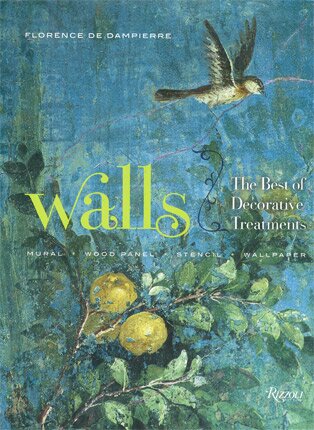
The chapter begins with a rundown of stenciling through the ages, hitting the Paleolithic caves at Lascaux, stenciling in ancient Egypt, Rome, China, and the Middle East, and it just gets better and better from there. I am just sharing some tidbits and highlights here to give you a taste of this delicious volume. So, come with me (and dear Florence) on a brief tour of stencils and stencil art through the ages….

The photo above shows 15th century stenciling on plaster walls from the King’s Room of the Treasurer’s house in Yorkshire, England.Stenciled pattern became an integral part of wall decoration throughout Europe, beginning in the 14th century after being introduced in England in the Middle Ages. Stenciling was used extensively along with handpainted accents and to frame murals in castles and churches throughout England, France, and Italy during this time.
Alas, stenciling has always been prone to getting “a bad rap”, even in the 16th century. Stenciling on walls nearly disappeared for awhile after a trade group, the Painter-Stainers Company of London declared stencils as
“a deceitful work and destructive of creative painting, being a great hinderer of ingenuousness, a cherisher of idleness and laziness in all the said art”.
I respectfully beg to differ….I have heard sentiments along these lines over the years, but have always viewed stenciled as an amazing tool for creativity and artistic expression. And besides, even if they are used just to bang out printed pattern on a wall, the end result is a product of hand crafting and self-expression. So there!
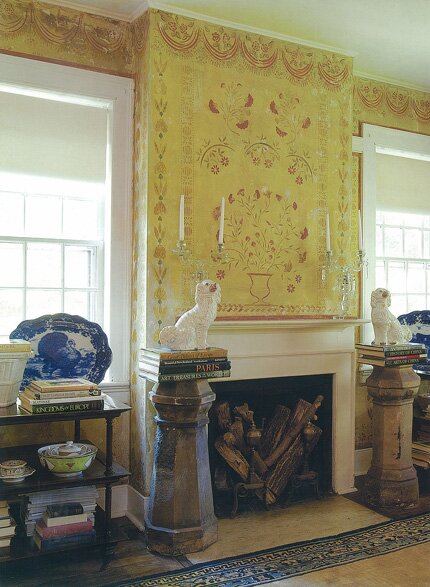
The photo above shows restored stenciling from a former 1780′s inn and tavern in New England. This quintessential type of stenciled pattern was common throughout colonial America. More economical than wallpaper, it was also “sold” as a more sanitary way to decorate walls; wallpaper at the time could be a breeding ground for bugs and other vermin. Eewwwww. The stenciling was typically done by travelling, itinerant painters who would work in exchange for room and board. They mixed their paint from skimmed milk, lime, oil and whiting (finely ground chalk) and tinted it with pigments taken from their environment. The color red could come from iron filings, brick dust, or berry juice. Yellow came from clay, black from soot, and green could come from the green rust of copper (verdigris). Most of these artists remain nameless. However, the discovery of Moses Eaton’s stencil kit containing 78 stencils in the 1930′s allowed for the match of his hand cut patterns to a large body of remaining stenciled walls throughout New England. It was exactly THIS type of stenciling that drew me in to this artform back in the 80′s during a trip to New England, and I must say that this is looking rather lovely to me all over again!

Rufus Porter was another well-known stencil artist of the time, whose specialty was stencil enhanced fresco murals depicting villages and landscapes. With the help of stencils, Porter could paint a whole room with a fanciful scene in about 5 hours. Not only was this more economical than mass-produced wallpaper of the time, it was also considered to be more stylish and less impersonal. The same could be said of stencils vs. wallpaper today-and I just said it!
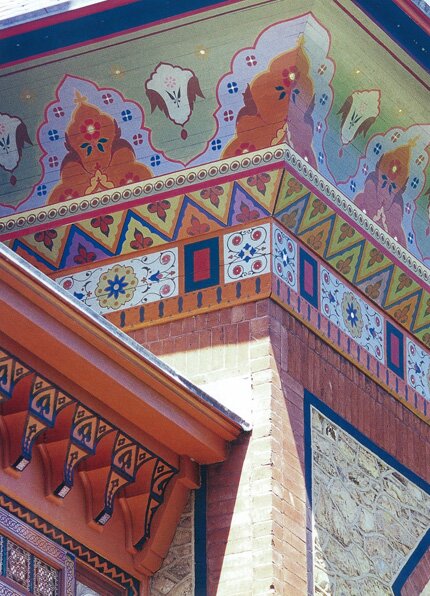
After falling out of favor yet again, stenciling made a somewhat brief comeback in the United States during the Victorian era of the late 1800′s, with an emphasis on “elaborate”. None other than Louis Comfort Tiffany (yes, the lamps!) designed stencils for Mark Twain’s New England home and for his own mansion on Long Island, where he filled his walls with stenciled canvases filled with Islamic, Indian, and Mediterranean motifs. Another artist of the time, Frederic Edwin Church, also shared a love of “Orientalism”, and the beauty and abilities of stenciled pattern after traveling through the Middle East and Europe. A well-known fine artist of The Hudson River School of Painters, Church filled the walls and surfaces of HIS Hudson River mansion, Olana (which one can VISIT today!) with gorgeous color combinations and arabesque motifs.
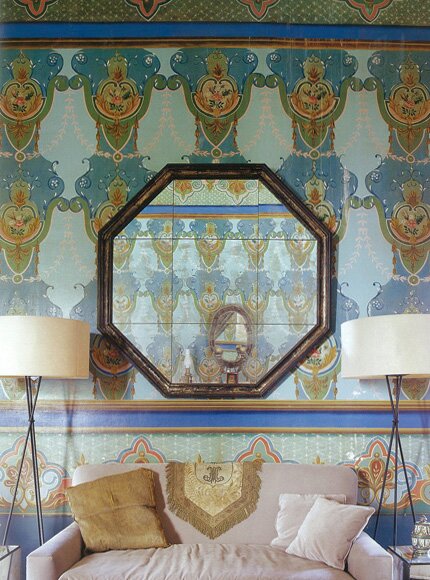


There are also many rich examples of stenciling throughout Mexico, and most prominently in the town of San Miquel de Allende. Stencil patterns in Mexico represent a blend of native indian, conquering Spanish, and even 19th century french design-all of which are on gorgeous display in the three photos above.
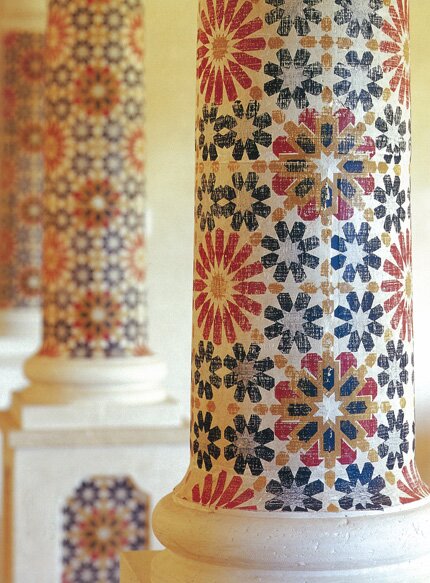
Moving on to more contemporary applications, there are some very well-known designers who appreciate the beauty, flexibility, and artistry that stenciled patterns can add to an interior design scheme. Sometime they are used as subtle accents, and sometimes they MAKE the statement, as is the case of this Moroccan stenciled pattern as used by designer Martyn Lawrence-Bullard in a Los Angeles dining room. I shared some more of Mr. Lawrence-Bullard’s work recently in this blog post. He certainly DOES have an elegant way with stencils.
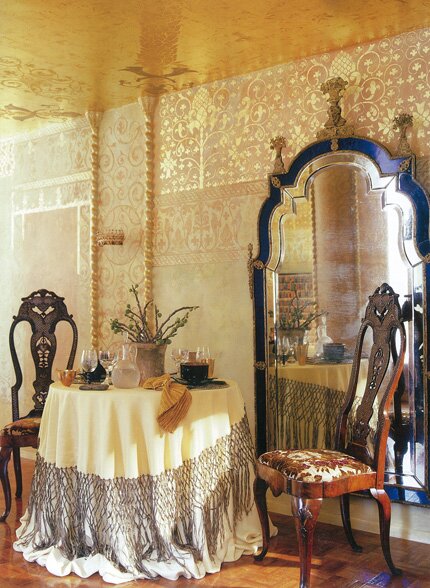
And lastly, and speaking of elegant, this has to be one of my favorite stencil applications ever: gilded wall and ceiling stenciling by Joseph Shoskovitch in the New York City apartment of fashion designer Mary McFadden. This aesthetic is a true reflection of the designer’s tastes and creations, which pull heavily from ancient civilizations and exotic locations.
If you are miraculously NOT yet convinced that you NEED this book, check out this post on Katiedid which give a great overview on all the contents of the book. You see, it wasn’t ALL about stenciling; there are sections on the history of mural, wood panels, and wallpaper as well!












 Copyright © Designamour
Copyright © Designamour